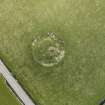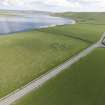Oxtro
Broch (Iron Age), Cist (Bronze Age), Cist(S) (Prehistoric), Cremation(S) (Prehistoric), Cremation (Bronze Age), Pictish Symbol Stone (Pictish)(Possible), Comb (Bone)(Prehistoric), Penannular Brooch (Bronze)(Prehistoric), Pin (Metal)(Viking), Unidentified Pottery (Roman), Vessel (Steatite)(Bronze Age)
Site Name Oxtro
Classification Broch (Iron Age), Cist (Bronze Age), Cist(S) (Prehistoric), Cremation(S) (Prehistoric), Cremation (Bronze Age), Pictish Symbol Stone (Pictish)(Possible), Comb (Bone)(Prehistoric), Penannular Brooch (Bronze)(Prehistoric), Pin (Metal)(Viking), Unidentified Pottery (Roman), Vessel (Steatite)(Bronze Age)
Alternative Name(s) Haughster; Okstrow
Canmore ID 1789
Site Number HY22NE 4
NGR HY 2537 2678
Datum OSGB36 - NGR
Permalink http://canmore.org.uk/site/1789
- Council Orkney Islands
- Parish Birsay And Harray
- Former Region Orkney Islands Area
- Former District Orkney
- Former County Orkney
Oxtro, Birsay, Orkney, Pictish symbol stone
Measurements:
Stone type:
Place of discovery: HY 2537 2678
Present location: lost.
Evidence for discovery: found acting as a cover slab for a short cist during excavation of Oxtro broch-mound in 1847. The cist was one of a cemetery overlying the demolished broch. Subsequently it was built into an outbuilding at Boardhouse Farm and attempts to locate it have failed.
Present condition:
Description
This stone was incised with an eagle, but it is not known whether this was part of a larger stone or whether it was a stone with a single symbol. The size of the stone as it survived is unknown.
Date: seventh or eighth century.
References: Ritchie, J N G 2003, 121; Watters et al 1995, 2; Fraser 2008, no 170; Scott & Ritchie 2014, no 4.
Compiled by A Ritchie 2016
HY22NE 4 2537 2678.
(HY 2537 2678) Haughster Brough (NR) (Stone Cists, Deer Horns etc found A.D.1847)
O.S.6"map, Orkney, 2nd ed.,(1900).
Before excavation, Haughster, Okstrow or Oxtro broch was a pile of stones on a knoll. It was excavated by Mr Leask, of Broadhouse Farm, in 1847.
On removing the stones, many short cists, containing burnt bones and ashes, were found. One of the cists contained a large bowl-shaped stone urn, in which were ashes and fragments of bones, and another contained a bronze ring. The figure of an eagle was carved on one of the cist-covers but this stone was built into one of the farm offices at Boardhouse.(G Petrie 1859; J Curle 1932).
Beneath the cists were found the remains of a broch, 69 ft in diameter overall, the wall 12 ft thick. Since excavation, about three-quarters of the wall is visible, up to five courses high, and two ruinous chambers The excavation yielded a collection of finds covering most of the first millenium A.D. which included a Viking bronze ring-headed pin and penannular brooch, native pottery and Roman sherds, including 2nd or 3rd century Samian.
Much of this material is in the National Collection.(PSAS 1876)
RCAHMS 1946; Name Book 1880; S Grieg 1940; R W Feachem 1963.
Oxtro Broch is as described above, except that the remains of a third cell, possibly a guard chamber, can be seen on the NW side.
There is no trace of the inscribed cist-slab at Boardhouse.
Resurveyed at 1/2500.
Visited by OS(NKB) 28 May 1967.
Classification of Roman material.
A S Robertson 1970.
Class I symbol stone (lost) bearing an eagle.
A.Mack 1997 p.143
'The Orkney Herald' and 'The Orcadian' mentioned the site a number of times in the 1860s.
Antiquarian Observation (1862 - 1870)
Drawings by George Petrie of sites in Orkney and Shetland in sketchbook MS 28/487/7 in the Society of Antiquaries of Scotland Collection.
Publication Account (2002)
HY22 4 OXTROW (‘Oxtro’, 'Haughster Howe' or 'Okstrow')
HY/25372678
A probable solid-based broch in Harray with exceptionally thin walls and standing on flat ground near a loch.
Mr. Leask of Boardhouse (Birsay) employed men to move a pile of stones in 1847: he first found many cist graves and fortunately George Petrie was able to examine them before they were destroyed [2]. They were made of flagstones and from 75 - 90 cm (2.5 - 3 ft.) long and about 45 cm (18 in.) wide and deep, and contained burnt bones and ashes. An "eagle" was supposed to have been cut boldly into one of the capstones but this was built into a wall before Mr Leask could recover it for Petrie. One of the cists had a bowl-shaped stone vessel with ashes and fragments of bone.
Petrie continued the excavations below these cists and found the ruins of a circular building, probably a broch, the walls of which were at that stage still standing up to 1.8 m (6 ft.) high; the ruins now stand scarcely 60 cm (2 ft.) above the surrounding field. Petrie [2] and Laing [ ] supposed that the broch belong to the Stone Age at the latest because they thought the cists to be of Bronze Age date; the broch was of course in ruins and covered by earth before the cists were inserted into the “howe”. This diagnosis was made in spite of the fact that a sherd of Roman Samian ware had been found in the broch.
Part of the wall in the west arc had been destroyed before Petrie arrived and this doubtless contained the main entrance. A mural stair was uncovered at about 3 o'clock, with a stair-foot cell to the left and steps rising to the right. A long mural cell was at about 11 o'clock with the doorway to the central court at one end of it instead of, as is more usual, at the centre. A well was found in the central area with a drain leading from it towards the broken area where the entrance probably was. There was supposed to have been a straight wall running across the inner court and overriding the well: it would therefore have been a secondary insertion. Also probably secondary were several radial slabs on edge against the inner wall face. Doubts about the reliability of the drawings of these feature on the site plan have been expressed [8, 56]. Part of the wall of the cell is still visible.
The date of the broch can be assigned to within the Iron Age because of the fragment of Roman pottery if for no other reason. The cist graves inserted into its ruins are therefore not Bronze Age in date but even later than the broch. The "eagle" supposed to have been seen on one of the capstones suggests that the cemetery may have been Pictish, in part at least, but even so the cremations inside the cists, sometimes in pots, suggest that a very ancient funerary tradition had survived on Orkney from pre-Iron Age times.
Dimensions. According to Petrie the overall diameter is about 21.0 m (69 ft.), the internal diameter exceptionally large at 13.7 m (45 ft.); thus the walls proportion is unusually low at 34.8%. Measurements from SSW to NNE in 1963 gave an overall diameter of 21.8 m (71 ft. 7 in.) and a wall thickness at the latter end of 3.8 m (12.5 ft.); the wall proportion would thus be 34.9%. Accurate measurements of the surviving inner wall face in 1985 revealed that the central court is constructed very precisely around a true circle with mean radius of 6.83 +/- 0.12 m, or a diameter of 13.66 m (44.79 ft.)
Finds [5]: all are unstratified, some have not been traced [8, 57] and the more important include the following.
Bronze , 1 zoomorphic penannular brooch ([3] fig. 2; [4] fig. 218: GD 52), 1 decorated pin with loose ring-head of Viking age ([9, 148-9]): [5] fig. on 85: [3] fig.2: GD 52), 1 Iron Age tankard handle [3, fig. 219; 10 pl. IX.2: 12, 2, no. 291) and 1 ring.
Silver: after the excavation a cylindrical piece of silver some 6.3 cm (2.5 in.) long and 1.9 cm (0.75 in.) in diameter was found in the well but melted down ([2] 87).
Bone objects included at least 3 long-handled combs (GD 26 and 27), 1 femur-head whorl or button (GD 23), a globular head of an iron pin (GD 22), 1 ring (GD 23), a pin with a decorative terminal and a hipped shank, and a possible slotted handle.
Stone objects include lamps, one of which seems to be an imitation of a Roman lamp (GD 9, 10 and 11), several "very rude" vessels of various sizes, several beads or whorls, including one decorated (GD 19) , 5 hammerstones, 1 polished disc 9.5 cm (3.75 in.) in diameter, 1 chipped disc 6.3 cm (2.5 in.) in diameter, and 3 whorls. There was also a Pictish symbol stone.
Pottery: among the sherds found is preserved an everted rim (GD 47) and the rim of a coarse, gritty urn (GD 50). A complete list of the finds has been compiled [8: 9, 57].
Roman finds included half the base of a Samian vessel of the late 2nd or 3rd century AD ([6 Curle 1932, 395].
In the Hunterian Museum there are also a stone spindle whorl and a bone awl from the site, probably from the J W Cursiter collection (B.1914.551 and 552).
Sources: 1. OS card HY 22 NE 4: 2. Petrie 1890, 76-8 and 86-7: 3. Laing 1867, 64: 4. Anderson 1883, 2, 240-1: 5. Proc Soc Antiq Scot 11 (1876-77), 86-7 (donations): 6. J. Curle 1932, 394-5: 7. RCAHMS 1946, 2, no. 11, 11-13 and fig. 67: 8. Hedges et al. 1987, 55-8 (including other sources not mentioned here) and pl. 3.1 (ms elevations by Dryden): 9. Grieg 1940: 10. Corcoran 1952: 11. Fraser 1925: 12. MacGregor 1974.
E W MacKie 2002
Note (2020)
Oxtro
This burial site in Orkney Islands was a focus for funerary practices in the Bronze Age period, between 2450 BC and 801 BC.
Prehistoric Grave Goods project site ID: 60036
CANMORE ID: 1789
Total no. graves with grave goods: 1
Total no. people with grave goods: 1
Total no. grave goods: 1
Prehistoric Grave Goods project Grave ID: 74241
Grave type: Cist
Burial type(s): Cremation
Grave good: Vessel (Unknown/Unspecified)
Materials used: Steatite
Current museum location: Unknown
Further details, the full project database and downloads of project publications can be found here: https://doi.org/10.5284/1052206
An accessible visualisation of the database can be found here: http://blogs.reading.ac.uk/grave-goods/map/














































